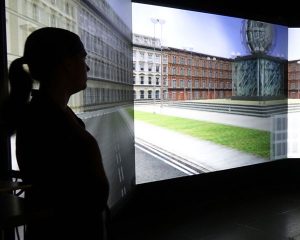As a researcher in design computing at The Pennsylvania State University, Danielle Oprean currently holds the role of Post-Doctoral Research Scholar in the Stuckeman School for Design Computing (SCDC) where she conducts research, writes grants, and teaches courses. She has revitalized the Immersive Environments Lab (IEL) and acts as the coordinator for the facility offering visualization solutions through virtual reality technology to the Stuckeman School (Architecture, Landscape Architecture, and Graphic Design). She also collaborates with several other departments across the Penn State campus including: Geography, Mass Communications, and Architectural Engineering.
In her PhD in the Design with Digital Media track, she studied the impact of different immersive technology on spatial understanding of digitized spaces. To do this she helped write grants and build the Immersive Lab (iLab) that resides within the MU Architectural Studies Department. She also conducted research in the areas of design collaboration through various technology solutions including the Creative Convergence Network (CCN) with Dr. Newton D’souza. Her work during her PhD translated into the work she now does at Penn State, enabling her to revitalize the IEL and write grants to further research. Danielle’s current line of inquiry is in understanding how immersive technology can disseminate complex spatial concepts through different visual and interactive means for both individuals and collaborations.

Danielle Oprean
Researcher In Design Computing, The Pennsylvania State University
What helped you from MU’s Architectural Studies?
“My time at Mizzou in the Architectural Studies program was both long and rewarding in a number of ways. I gained great experiences in conducting research as well as writing grants through the mentorship of my advisors, Dr. Bimal Balakrishnan and Dr. So-Yeon Yoon. Building and establishing the iLab was one of the most rewarding experiences and it became the center of my PhD work. I came to the program with a visualization background and through the support of the faculty over the years was able to shape my knowledge base towards a better understanding of human behavior and responses to the environment. This new knowledge helped guide my work in understanding how visualization technology aids in development and use of digital spaces. Lastly, my peers were one of the greatest assets from my time at Mizzou. We were a close group who were able to support each other through the program and I am grateful for the opportunity to have gone through the program with them.”